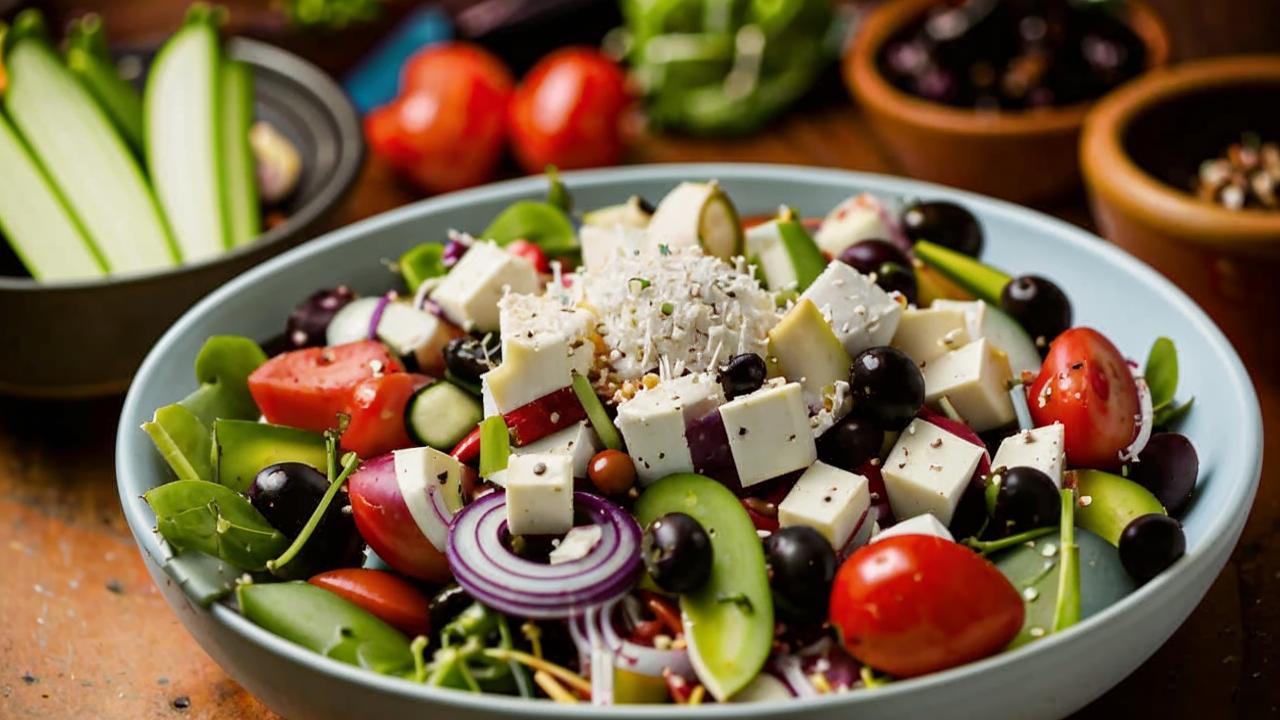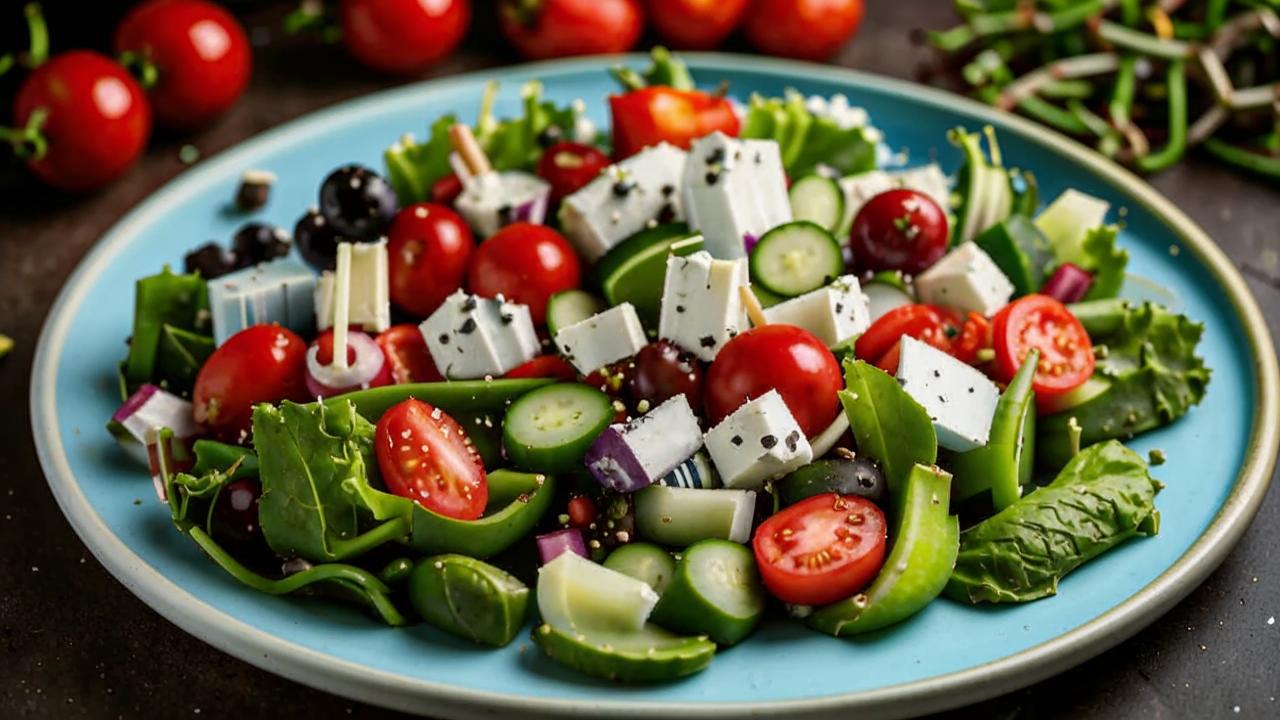Greek salad is a staple of simple Mediterranean cuisine. It is a simple, refreshing and very healthy dish consisting of only a few ingredients.
History of Greek salad
Greek salad is one of the symbols of Greek cuisine. In Greece, it is often called “choriatiki” (village salad) or “terini” (summer salad).
The roots of the dish can be traced back to ancient Greece, where the main ingredients of the salad were staples in the local diet. However, the modern version has undergone changes over time.
The Greek salad (as we know it today) is believed to have been invented in Plaka in the 1960s by restaurateurs in touristy Athens. Local food vendors found ways to get around fixed government tariffs on tomatoes, cucumbers and other vegetables.
They added feta cheese to a salad of vegetables with a price set by the authorities and thus created a “new” dish for which they could set their own price without government interference. That is, the Greek salad was probably created in an attempt to take advantage of a loophole in the law at the time.
The dish, named “choriatiki” as a reference to its humble rural origins, became a hit with locals and tourists alike. Over time, other chefs and restaurateurs added olives, onions and sometimes even green peppers to the recipe, creating the dish we know and love as Greek salad.

There are other versions of the dish’s origin. One of them says that the salad came about thanks to a young man who grew up in a Greek village. He was very fond of local vegetables, especially olives, olive oil and feta cheese. In search of a better life, the young man traveled to America to work. After a few years, he returned to his homeland, dreaming of trying his favorite foods again.
However, he faced a problem: because of a toothache, he could not chew vegetables, which in those days were eaten whole. That’s when he came up with the idea of cutting all the foods into bite-sized pieces. He added olives, seasoned everything with olive oil, and put a large piece of feta cheese on top. To his surprise, this way of serving the vegetables turned out to be not only easy to eat, but also very tasty.
His loved ones tried the new salad and were delighted. The next day, the young man’s sister served this salad on the wedding table, and it made a real sensation among the guests.
Rumors about the unusual village salad quickly spread, and now Greek salad has become one of the most popular dishes in the world.
The ingredients of Greek salad
Salad contains a lot of nutrients – it is a complete and useful dish. There are a lot of vitamins (including A and C), fiber, healthy fatty acids from olive oil, animal fats from feta cheese, there is iron, potassium, as well as antioxidants and phytonutrients.

Such a rich composition has a positive effect on the body, reducing the risk of disease and improving health.
There are many variants of Greek salad, but the classic version includes the following ingredients:
- cucumbers – 2 pcs;
- tomatoes – 2 pcs;
- feta cheese – 200 g;
- olives – 15 pcs;
- red onion – 1 pc;
- olive oil – 3-4 tbsp. l;
- salt, pepper, oregano – to taste.
Preparation of Greek salad
Greek salad is prepared quite simply and, as we have already realized, from available ingredients.
Step 1: Selection of products
Vegetables for the dish should be fresh, elastic. Before cooking, they need to be thoroughly washed. Tomatoes are better to choose the juiciest, red. As a decoration, you can use cherry tomatoes.
For salad dressing, use high-quality virgin olive oil.
The cheese should be exactly feta. It is a Greek white cheese made from sheep (or partially goat) milk and aged in brine. There are three types of feta available in stores: hard, medium hard and soft. Softer versions may be made from cow’s milk. Therefore, study the composition when choosing this ingredient.

In the traditional version of the dish, olives with pips are used. Without seeds, they quickly lose elasticity.
If feta and olives will be salty, do not add additional salt to the salad.
Step 2: Methods of cutting vegetables
Vegetables in Greek salad should be cut rather coarsely, not in small cubes.
If the cucumbers have a thick rind, partially cut it off, leaving a few strips on the vegetables to give them a rustic look. Cut them, like tomatoes, into thick crescents.
Red onions are sliced into thick crescents. If it is too bitter, you can soak it in water before serving.
Step 3. Assembling the salad
You need to mix the prepared tomatoes, cucumbers, red onions, then add a handful of olives. In the classic version of the recipe, feta cheese is not cut into cubes, but put one or two large pieces directly on top of the salad.
Step 4: Salad dressing
If the cheese and olives are salty from the beginning, there is no need to season the salad with salt. Add freshly ground black pepper and then drizzle a generous amount of extra virgin olive oil over the salad.
The quality of the olive oil makes a big difference, so choose a good one.

Finally, sprinkle the salad with the dried oregano, focusing on the feta cheese where the herb’s flavor will be most pronounced.
Gently rub the seasoning between your fingers, this action will release its essential oils.
Step 5: Serving and serving
Traditional Greek salad is served in a flat bowl rather than a deep bowl. It is garnished with whole olives and large chunks of feta cheese. The salad is served as a lunch dish on its own or as a side dish to meat and fish, especially when grilled.
Serve Greek salad with bread with which to dip the juice at the bottom of the plate.
Recipe variations

chef at City Farm at VDNH.
“Told about variations of Greek salad.”
Shopa salad
This dish comes from Serbia and Bulgaria.
Unlike the Greek one, in it cheese is grated, and it looks more rustic. It has been a frequent guest in restaurants and canteens since Soviet times.
Ingredients:
- tomatoes – 2 pcs;
- cucumbers – 2 pcs;
- red onion – 1 pc;
- bell pepper – 1 pc;
- bryndza – 100 g;
- olive oil – 3-5 tbsp;
- salt, pepper – to taste.

Preparation:
- Cut the vegetables into large slices, and the onion – finely.
- Cheese should be grated and put on top of the salad.
- Season the dish with olive oil, salt and pepper.
Italian Panzanella
Italians offered their own version of Greek salad, which is called Panzanella. One of the components of the dish is crispy pieces of bread.
Ingredients:
- tomatoes – 2 pcs;
- cucumbers – 2 pcs;
- red onion – 1 pc;
- bell pepper – 1 pc;
- lettuce (Aisberg or Romano) – 150-200 g;
- bread (ciabatta or pita) – to taste;
- olive oil – 3-4 tbsp. tbsp;
- lemon – 1 tsp;
- salt, pepper – to taste.
Preparation:
- Cut tomatoes, cucumbers, onions and peppers into large slices, shred lettuce with your hands.
- Add coarsely torn pieces of baked ciabatta, pita or other bread.
- Season with olive oil, salt, pepper and a squeeze of lemon juice.
Greek salad option with meat
Those who like meat, you can add thinly sliced ham, beef jerky, smoked turkey or roasted chicken fillet to the dish.
Ingredients:
- components of the classic version of Greek salad;
- chicken fillet – 2 pcs;
- soy sauce – 3-4 tbsp. l;
- vegetable oil for frying;
- garlic – 4 cloves.

Preparation:
- Fry the chicken fillet in a frying pan on all sides.
- Add soy sauce and garlic to the meat, bake in the oven until ready.
- Slice the chicken into thin slices and add to the Greek salad prepared according to the traditional recipe.
To enhance the flavor of the salad, you can use specially infused oil.
For one bottle of any refined oil add five halved peeled garlic cloves, five sprigs of rosemary and thyme, for those who like spicy – half a chili pepper. Remove to the refrigerator overnight.
Greek salad with seafood
Ingredients:
- tomatoes – 2 pcs;
- cucumbers – 2 pcs;
- red onion – 1 pc;
- bell pepper – 1 pc;
- feta cheese – 100 g;
- seedless olives – 16 pcs;
- shrimps or squids – 100-150 g;
- lemon – 1 tsp;
- olive oil – 3-4 tbsp. l;
- salt, black pepper – to taste;
- fresh herbs (dill, parsley) – to taste.

Preparation:
- Boil or fry seafood until ready.
- Cut tomatoes, cucumbers, red onions and bell peppers into cubes or half rings.
- Add the seafood, olives and diced feta cheese to the bowl.
- Season the salad with salt, pepper, olive oil and a squeeze of lemon juice.
- Sprinkle with chopped herbs and mix thoroughly.
Greek salad with quinoa and nuts
Ingredients:
- tomatoes – 2 pcs;
- cucumbers – 2 pcs;
- red onion – 1 pc;
- bell pepper – 1 pc;
- feta cheese – 100 g;
- seedless olives – 10 pcs;
- quinoa – 150 g;
- walnuts or almonds – 10 pcs;
- lemon – 1 tsp;
- olive oil – 4 tbsp;
- salt, black pepper – to taste.

Preparation:
- Rinse the quinoa under running water, then boil it in salted water according to the instructions on the package (usually 15-20 minutes).
- While the quinoa is boiling, dice the tomatoes, cucumbers, red onion and bell pepper into cubes or half rings.
- Allow the quinoa to cool to room temperature.
- In a large bowl, mix together the chopped vegetables, olives, and diced feta cheese.
- Add the cooled quinoa and nuts.
- Season the salad with salt, pepper, olive oil and a squeeze of lemon juice.
- Mix thoroughly and serve.
You can also add avocado, beans or chickpeas and even berries like pomegranate or cherries to the salad.
Enjoy!





